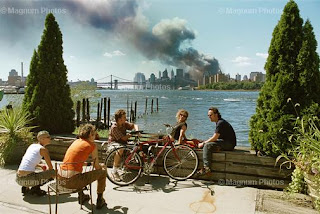Henri Cartier-Bresson
Henri Carter-Bresson to give him his full title is a French photographer who was born in 1908 and passed away in 2004. He was considered to be one of the best or not the best photojournalism photographer the world has ever seen. His concept of photography for capturing great images was what he called “The Decisive Moment”. The Decisive Moment was tended to give the impression that Cartier-Bresson believed that story-telling, the catching on film of the historic moment, was the essence of good photography.
Bresson also stated that the Decisive moment is the decisive moment, “it is the simultaneous recognition, in a fraction of a second, of the significance of an event as well as the precise organization of forms which gives that event its proper expression”. For capturing his images he used a 35mm Film camera made and developed by the company Leica. He used this camera as it was, small lightweight and easy to use. The company Leica was founded in 1913, in Germany by Alfred Schopf who was at the time the CEO of the company. The development of the technology is in my opinion what allowed him to make this decisive moment using his 35mm film camera.
He described his camera when capturing images an extension on his eye. He often said that the creative part of photography is very short, “A painter can elaborate a writer can, but as its given, we have to pick that moment the decisive moment. “ (Bresson).
Whilst he was out shooting and finding the decisive moment he only ever shot his images in black and white and never changed over to colour when the time came around. He also never used a flash to fill areas he always wanted an image to look as pure as what he could see it through the viewfinder of his Leica, He also only ever used one lens which was a fixed focal length 50mm lens.
After the images were taken and it came to the time were the images were to be developed he never found that his images wanted cropping, he always kept them the same as when they were taken. He saw his camera as a tool and a way of drawing or painting an image just like when you use a brush to create a painter.
In 1939 Bresson was unlucky as he was one of many that was in the war as a corporal but he worked for a special unit, which was the film and photo unit. After joining the war he was captured as a prisoner of war for 3 years, however he did eventually mange to escape in 1943 were he then fled to the French capital, Paris were he worked with the French resistance. He worked with the photographic unit in particular and he recorded the Nazi’s occupation and the liberation.
After the war was over and many years later, Bresson was persuaded to join Magnum photos.
Peter Conrad who worked for the Observer in 2004 wrote about Henri Bresson and stated the following about him, “A great, pioneering photographer his pictures which captured not just Paris but the globe, not just everyday life but world- changing events, are emblems of 20th Century extensive”.
He had his first ever exhibition in Madrid, Spain, in 1933. Later in that year he also had another show in the place were many people wish to have a exhibition this place is of course New York City in America.
My personal response to his images are mixed as some of his images I found quite remarkable and a thrill to look at were as some of them I find aren’t very good. The image below is one that Bresson has captured of a couple sat on a Hill over looking a river as a boat passes by on it. I find this image uninspirational as to me in my opinion it looks like a typical holiday snap. Were as the image furthest to the bottom is an image that I find is a true image and one that people will enjoy to look at just as much as I do. In the image You can see a set of stairs that run down to a low level street were a passing cyclist can be seen passing in the distance.
When looking deep into the image you can see that the cyclist is slightly blurred and a little out of focus. I find that this technic has worked well in the image as it gives a sense of movement. The way the image is a little dark at one side also works well as it leads your eye down the stairs and to the cyclist that is passing by.
The two lines below are links to some resources that I have found of Bresson, and what people have said about him.
http://www.guardian.co.uk/news/2004/aug/05/guardianobituaries.artsobituaries











